
Summary:
This guide breaks down the essentials of VR mental health app development in a simple, human way. It explains how VR creates safe, immersive spaces for people dealing with anxiety, stress, depression, ADHD, and more. You’ll learn about real use cases, key features, the tech stack, development steps, costs, and what the future of VR therapy may look like. A quick, clear overview for anyone exploring how VR is reshaping mental wellness in 2026.
Life’s been moving in fast-forward lately. Some days it feels like you’re sprinting from the moment you wake up, and your brain is still stuck back at breakfast trying to make sense of the day. That’s kinda why VR mental health apps don’t feel futuristic anymore, they feel… necessary. Like that one quiet friend who doesn’t say much but always makes the room feel lighter.
Thanks to VR getting better, cheaper, and honestly less clunky (remember those huge headsets that felt like strapping a toaster to your face?), these apps now offer spaces where people can work through anxiety, depression, stress, or just general “life is a lot” moments. This guide breaks down what VR mental health app development really involves, no buzzwords, no stiff tone, just a straight walk-through. Let’s start.
What Is a VR Mental Health App?

A VR mental health app is basically a therapy… but inside a headset. You put on the headset, and suddenly you’re somewhere else. Maybe it’s a calm forest that smells like rain (okay, your nose knows it’s not real, but your brain doesn’t care). Maybe it’s a room designed to help you face something you’ve been avoiding. Maybe it’s just a moment of stillness you didn’t know you needed.
These apps help people deal with anxiety, stress, low moods, or even memories that are hard to unpack. They recreate everyday or emotional scenarios in a way that’s safe, controlled, and weirdly comforting. You get to pause. Retry. Step back. Try again. And that sense of control alone helps more than people expect.
Why VR Is Game-Changing in Mental Health Treatment (2026 Outlook)
Adding VR into therapy feels like someone finally decided to give mental health tools a modern update. It’s not magic, but sometimes it feels close.
Here’s why VR keeps showing up in conversations:
1. Immersive Experiences:
VR makes you feel there. Not looking at a screen, not imagining things. Actually in it. And for therapy, that presence can be powerful.
2. Accessibility:
No commuting. No awkward small talk in waiting rooms. No “oh god I’m late again.” Just therapy from wherever you feel least stressed, your bed, your couch, maybe even the floor if that’s your vibe.
3. Personalization:
These experiences can adjust to you. Your pace. Your comfort level. Your reactions. It feels less like a preset exercise and more like something built around how you actually feel.
4. Data Collection:
VR quietly notices things: breathing changes, body reactions, patterns. Stuff we often ignore in real life because, well, life’s noisy.
Put together, VR makes therapy feel more flexible and a bit more human, strangely enough.
Top Use Cases of VR in Mental Health
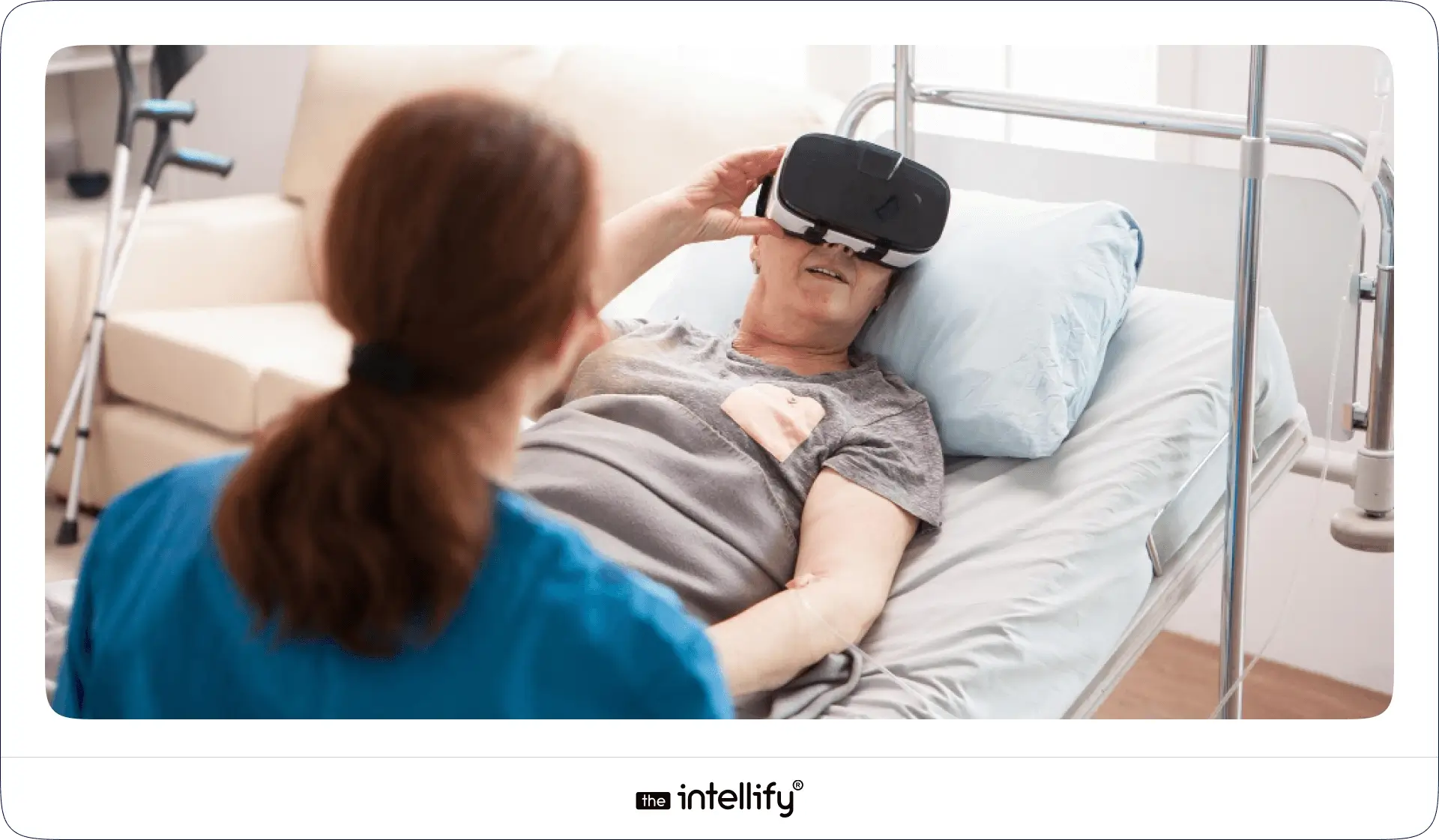
VR Exposure Therapy
Facing fears sucks. VR makes it suck less by letting you ease into them slowly. You’re not thrown into the deep end, just dipping toes, inch by inch.
VR for Stress & Anxiety Management
Calming visuals, soft sounds, guided breathing. It’s like stepping into a room where the world finally shuts up for five minutes.
VR for Depression & Mood Enhancement
Little mood-lifting environments, warm lights, gentle interactions, simple activities that don’t demand too much but give back just enough.
VR in Cognitive Behavioral Therapy (CBT)
CBT works better when your brain gets to practice in a semi-real environment. VR gives that middle ground where learning sticks more naturally.
VR for ADHD & Focus Training
Interactive tasks that help train focus without feeling like chores. Kind of like leveling up your attention span slowly, without pressure.
VR for Autism Support
Social scenarios without noise, judgment, or unpredictable reactions. Users can practice communication in a space that feels safer.
VR for Addiction Recovery
VR can recreate scenarios that trigger cravings but in a controlled space, where users can learn healthier responses without real-world risks.
Key Features to Include in a VR Mental Health App (2026 Edition)
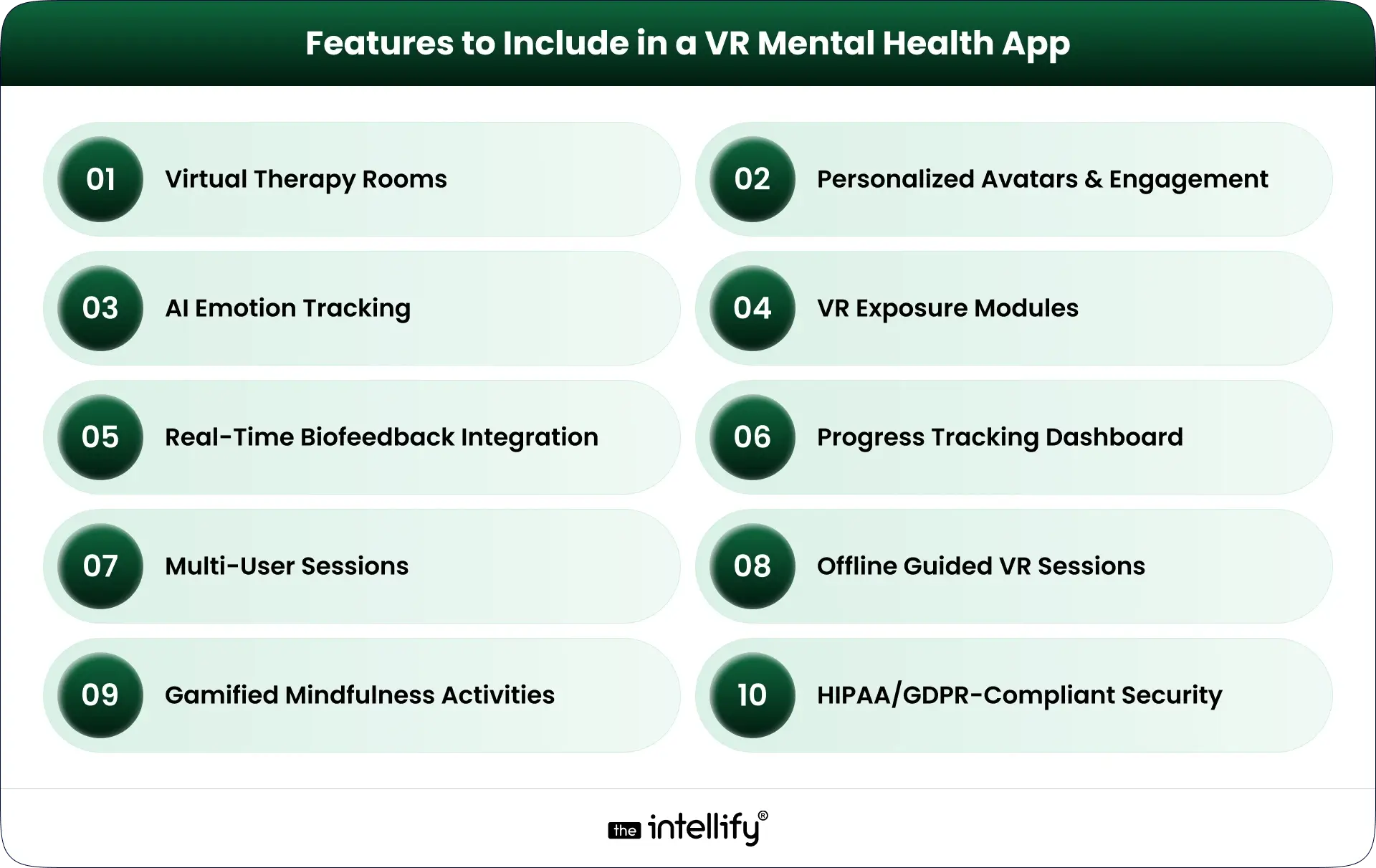
- Virtual Therapy Rooms: Simple, calm spaces for one-on-one or guided sessions. No clutter. No distractions.
- Personalized Avatars & Engagement: A bit of avatar customization helps users feel more at ease, especially during therapy interactions.
- AI Emotion Tracking (Facial + Voice + Biometrics): Tiny emotional cues matter. AI reads them gently through voice tone, micro-movements, biometrics, nothing invasive, just helpful.
- VR Exposure Modules: Structured steps that guide users through confronting fears safely, slowly.
- Real-Time Biofeedback Integration: Heart rate spikes? Breathing off? The app shows it, calmly, so users learn what’s happening inside their own bodies.
- Progress Tracking Dashboard: A simple dashboard showing progress, habits, streaks, all the little wins that matter over time.
- Multi-User Sessions: Group therapy without the pressure of being physically present. Users can join from wherever they are.
- Offline Guided VR Sessions: Because mental health support shouldn’t depend on good Wi-Fi.
- Gamified Mindfulness Activities: Small, thoughtful tasks that make mindfulness feel less like homework.
- HIPAA/GDPR-Compliant Security: User privacy is sacred. These apps must guard it tightly.
VR Tech Stack for Mental Health App Development
- Hardware Options (Meta Quest, Vision Pro, HTC Vive): Pick hardware users can actually tolerate for longer sessions. Comfort matters more than specs.
- Software Tools (Unity, Unreal Engine, AI Models): These tools help build smooth, immersive VR environments without the “lag headache” effect.
- APIs & Integrations: For emotion tracking, voice analysis, biometrics, basically the layers that make the app smarter.
Step-by-Step Development Process
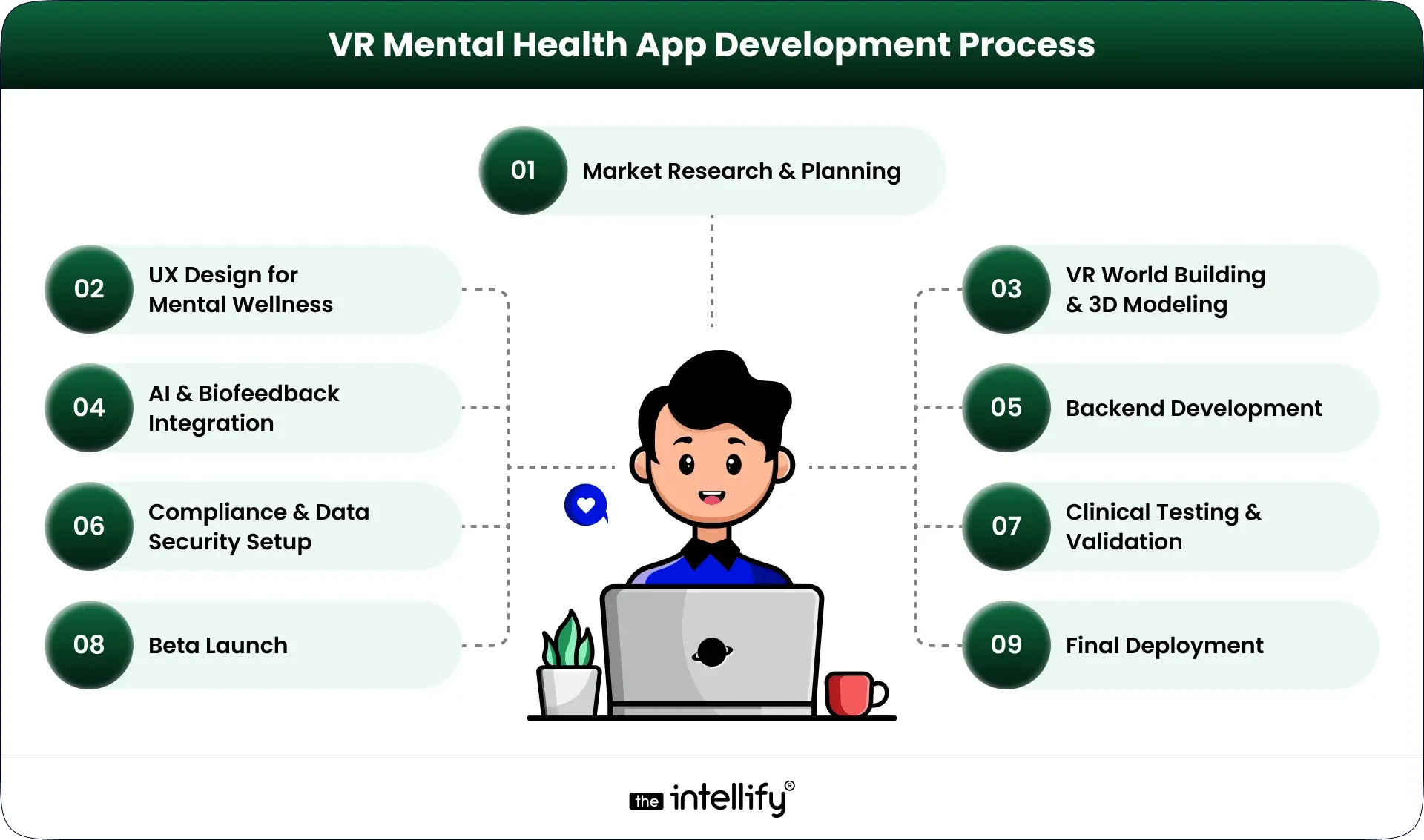
Step 1 – Market Research & Planning: Understanding what people actually need, not what sounds cool on paper.
Step 2 – UX Design for Mental Wellness: Quiet designs. Simple layouts. Buttons you don’t have to squint at. A flow that feels kind.
Step 3 – VR World Building & 3D Modeling: Environments should feel alive but not overwhelming. Think “soft presence.”
Step 4 – AI & Biofeedback Integration: Adding emotional awareness and physiological tracking.
Step 5 – Backend Development: The invisible stuff that keeps the app running smoothly without random crashes.
Step 6 – Compliance & Data Security Setup: Mental health = sensitive data. No shortcuts.
Step 7 – Clinical Testing & Validation: Therapists and real users try it, give feedback, tweak, repeat.
Step 8 – Beta Launch: A small group uses it. Honest feedback is gold here.
Step 9 – Final Deployment: Launch. Monitor. Improve. Apps grow just like people do.
Cost to Develop a VR Mental Health App in 2026
Most VR mental health apps cost somewhere between $150,000 and $1M+, depending on the world-building, features, hardware support, and testing required. More advanced AI, exposure modules, or clinical validation naturally push the cost higher.
How VR Mental Health Apps Make Money
- Subscription Models: Monthly or yearly access to content.
- In-App Purchases: Extra therapeutic modules or guided sessions.
- Partnerships with Therapists: Clinics using the app with their clients.
Challenges & Considerations
- High Development Costs: VR isn’t cheap to build well.
- User Adoption: Not everyone is comfortable with VR yet.
- Technological Limitations: Hardware access isn’t universal.
Future Trends in VR Mental Health (Beyond 2026)
- More Personalization: Therapy that adapts like a conversation, not a script.
- Integration with Wearables: Smartwatches and sensors feeding real-time emotional insights.
Why Choose Our Team for VR Mental Health App Development?
At The Intellify, we build VR mental health apps with input from real mental health professionals. We handle the tricky tech parts, security, compliance,and testing so the final experience feels smooth and actually usable for real people who need it.
Conclusion
Mental health is finally getting the attention it deserves, and VR mental health apps are opening doors that used to feel stuck. They let people explore, practice, pause, breathe without the pressure of the real world staring back. If you’re considering stepping into this space, now’s honestly a pretty good time to build something that could help someone.
Frequently Asked Questions (FAQ’s)
1. What is a VR mental health app, and how does it work?
A VR mental health app uses virtual reality to place users inside calm, controlled environments where they can face emotions or situations without real-world pressure. You slip on a headset, step into a guided scenario, and work through challenges at your own pace. It feels safe, immersive, and oddly reassuring.
2. How effective is VR therapy for anxiety, depression, and PTSD?
VR therapy tends to boost engagement because people feel more present inside the experience, not just talking about it. Research and early clinical use show real improvements in anxiety, low moods, and PTSD symptoms, especially when VR is combined with structured therapeutic guidance.
3. Which mental health conditions can be treated using VR therapy apps?
VR therapy apps are used for anxiety, PTSD, depression, ADHD, autism, and addiction recovery. They help people practice emotional responses, social skills, and coping strategies in a space that feels real enough to learn from but safe enough to pause anytime.
4. What features should a VR mental health app include in 2026?
A solid VR mental health app usually includes customizable avatars, calming therapy rooms, and AI tools that pick up emotional cues through face, voice, or biometrics. It should also support biofeedback, guided modules, and strong privacy compliance so users feel fully safe during sessions.
5. How much does it cost to develop a VR mental health app?
Most VR mental health apps cost somewhere between $150,000 and $1M+, depending on the world-building, features, hardware support, and testing required. More advanced AI, exposure modules, or clinical validation naturally push the cost higher.
6. Is VR therapy safe, and are there any risks or side effects?
VR therapy is generally considered safe, but some users may feel motion sickness, dizziness, or a bit of emotional overwhelm during intense scenarios. These effects usually fade as people get used to the environment or adjust their session settings.
7. Which VR devices are best suited for mental health applications?
Popular choices include the Meta Quest, Apple Vision Pro, and HTC Vive. They’re reliable, comfortable for longer sessions, and offer enough visual quality to support calm, immersive therapeutic experiences.
8. Why should businesses invest in VR mental health app development now?
The demand for accessible mental health tools is rising fast, and VR offers something traditional methods sometimes struggle with presence and comfort. Investing now gives businesses a head start in a space that’s clearly growing, both in need and innovation.

Written By, Jalaj Shah
The COO and Co-Founder of The Intellify. Jalaj enjoys experimenting with new strategies. His posts are fantastic for businesses seeking innovative development ideas. Discover practical insights from his engaging content.


AI in the Metaverse: Future Applications & What’s Next
Summary: This blog explores how AI in the metaverse is slowly reshaping the way we interact with digital spaces. It breaks down how AI personalizes virtual worlds, improves navigation, and makes avatars, environments, and conversations feel more lifelike. You’ll also find practical tips on getting started, plus a look at what the future may hold […]
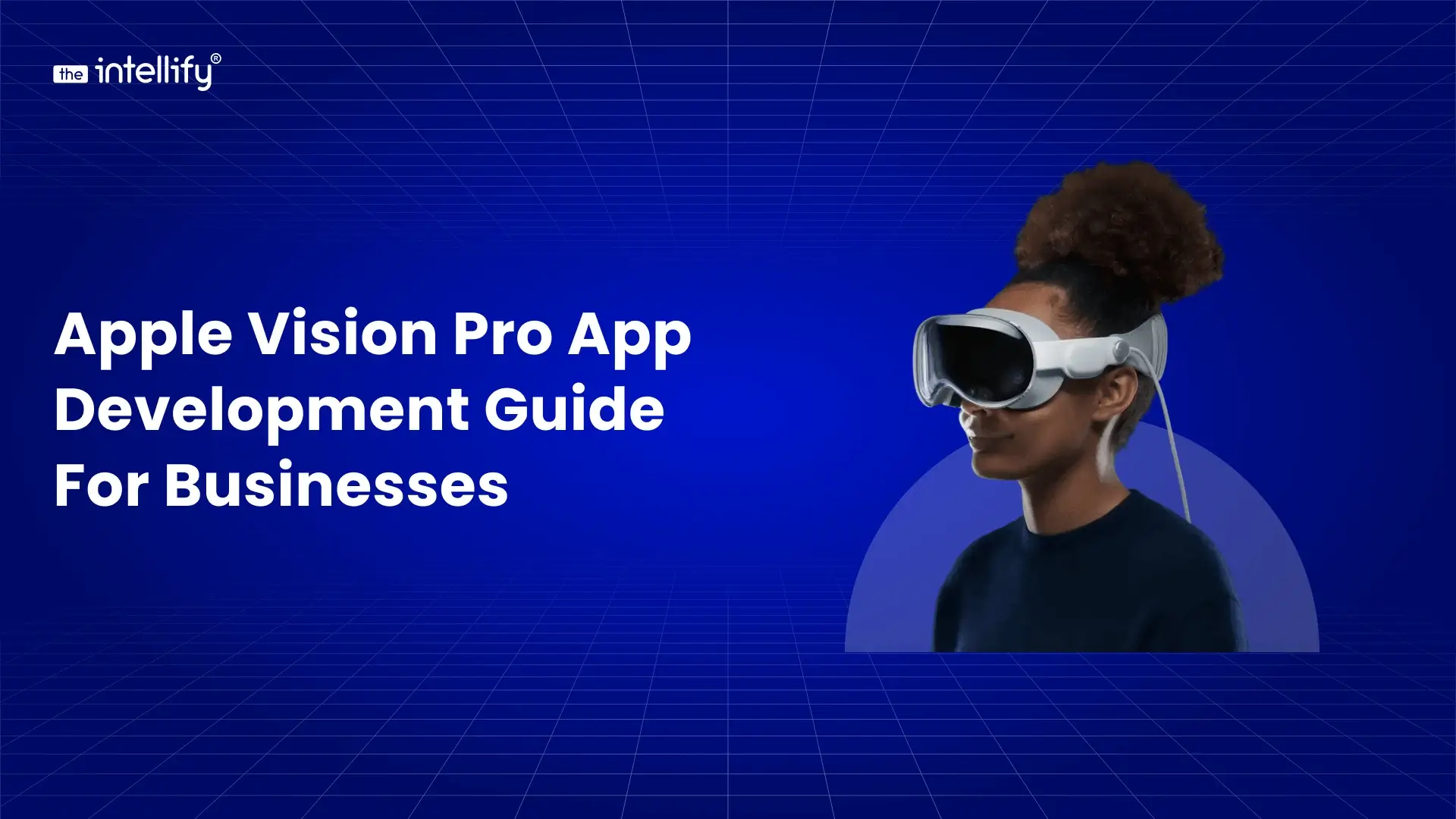

Apple Vision Pro App Development Guide for Businesses
Summary: This blog breaks down Apple Vision Pro app development in a simple, practical way for businesses exploring AR and VR app solutions. It explains what the device can do, where it fits across industries like healthcare, retail, education, and real estate, and how the full development process works from concept to launch. You’ll also […]
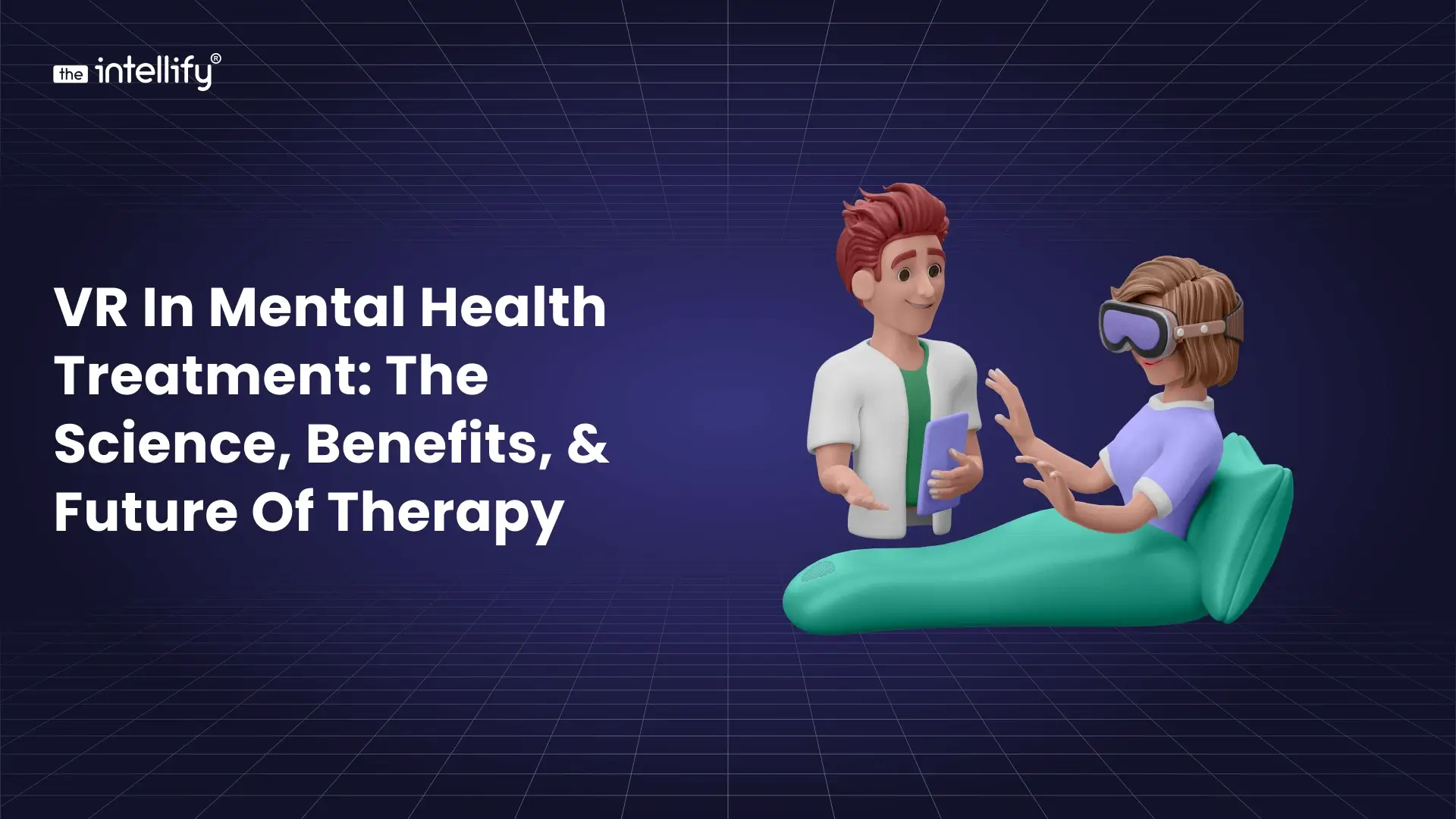

VR in Mental Health Treatment: The Science, Benefits, & Future of Therapy
Summary: VR in mental health treatment is redefining how people experience therapy, turning healing into something immersive, engaging, and deeply personal. This blog explores how virtual reality helps patients manage anxiety, PTSD, depression, and phobias through realistic, safe environments. It also unpacks the science behind VR therapy, its real-world benefits, and why this emerging technology […]


AI in the Metaverse: Future Applications & What’s Next
Summary: This blog explores how AI in the metaverse is slowly reshaping the way we interact with digital spaces. It breaks down how AI personalizes virtual worlds, improves navigation, and makes avatars, environments, and conversations feel more lifelike. You’ll also find practical tips on getting started, plus a look at what the future may hold […]


Apple Vision Pro App Development Guide for Businesses
Summary: This blog breaks down Apple Vision Pro app development in a simple, practical way for businesses exploring AR and VR app solutions. It explains what the device can do, where it fits across industries like healthcare, retail, education, and real estate, and how the full development process works from concept to launch. You’ll also […]


VR in Mental Health Treatment: The Science, Benefits, & Future of Therapy
Summary: VR in mental health treatment is redefining how people experience therapy, turning healing into something immersive, engaging, and deeply personal. This blog explores how virtual reality helps patients manage anxiety, PTSD, depression, and phobias through realistic, safe environments. It also unpacks the science behind VR therapy, its real-world benefits, and why this emerging technology […]
0
+0
+0
+0
+Committed Delivery Leads To Client Satisfaction
Client Testimonials that keep our expert's spirits highly motivated to deliver extraordinary solutions.


















